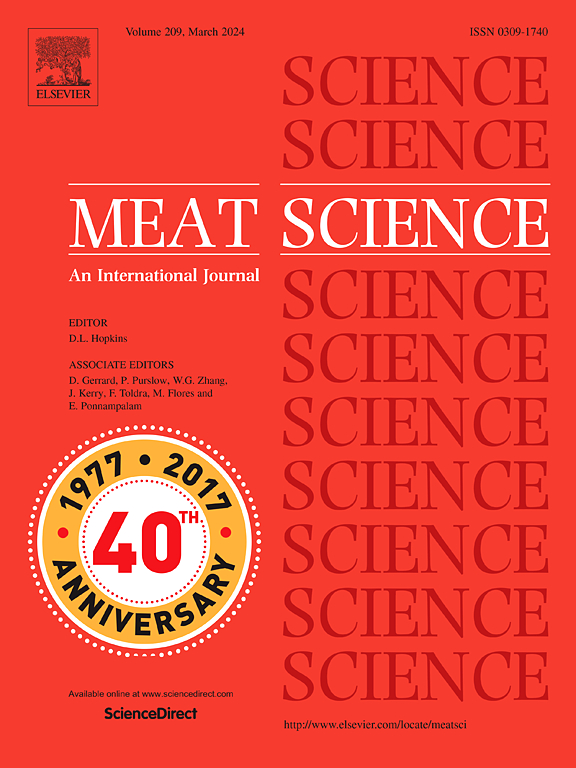可持续真空包装材料对冷藏羊肉的脂肪酸组成和氧化稳定性的影响可达20周
IF 6.1
1区 农林科学
Q1 Agricultural and Biological Sciences
引用次数: 0
摘要
采用8 × 4析因试验设计,利用384条腰最长肌(LL),研究了贮藏期和包装类型对羊肉脂肪酸和氧化稳定性生物标志物的影响。这包括冷藏期(第0周、第1周、第2周、第6周、第10周、第14周、第18周和第20周)、包装类型(PACK 1、Eco-tite®可回收收缩袋;pack2, Cryovac®屏障收缩袋;包装3,一个铝箔袋;和pack4, Biovac™可回收真空袋),以及它们的相互作用。研究发现,在PACK 3下保存的羊肉通常含有较高浓度的omega-3和omega-6脂肪酸。单不饱和脂肪酸受包装类型的影响较小。个别脂肪酸的浓度随冷藏时间的延长而变化,变化最大的是在第6周至第18周。脂肪酸指数和EPA + DHA证实,无论储存期限或包装类型如何,羊肉都与脂肪酸摄入有关,有利于健康。随着贮藏期的延长,α -生育酚浓度普遍升高,羰基含量普遍降低,但在整个20周的贮藏期内,TBARS和FRAP保持一致。总的来说,这些发现支持冷藏羊肉的保质期更长,可能超过先前文献中建议的10-12周。本文章由计算机程序翻译,如有差异,请以英文原文为准。
Sustainable vacuum packaging material influences the fatty acid composition and oxidative stability of chilled lamb meat stored for up to 20 weeks
The effects of storage period and packaging type on lamb meat fatty acids and oxidative stability biomarkers were investigated using 384 longissimus lumborum muscles (LL) and an 8 4 factorial experiment design. This included main effects of chilled storage periods (Week 0, 1, 2, 6, 10, 14, 18, and 20), packaging types (PACK 1, Eco-tite® Recycle Ready Shrink Bag; PACK 2, Cryovac® Barrier Shrink Bag; PACK 3, a foil pouch; and PACK 4, Biovac™ Recyclable Vacuum Pouch), and their interaction. It was found that lamb meat held under PACK 3 had generally higher concentrations of omega-3 and omega-6 fatty acids. Monounsaturated fatty acids were affected, but to a lesser extent, by the selection of packaging type. The concentration of some individual fatty acids changed with long-term chilled storage, with most change occurring between Week 6 and 18. The fatty acid indices and EPA + DHA confirmed that lamb meat supported health outcomes, associated with fatty acid consumption, irrespective of storage period or packaging type. Alpha-tocopherol concentrations generally increased, and carbonyl content generally decreased with storage period, although TBARS and FRAP remained consistent across the entire 20 week storage period. Collectively, these findings support a longer shelf-life for chilled lamb meat, possibly beyond the 10–12 weeks previously recommended in the literature.
求助全文
通过发布文献求助,成功后即可免费获取论文全文。
去求助
来源期刊

Meat Science
工程技术-食品科技
CiteScore
12.60
自引率
9.90%
发文量
282
审稿时长
60 days
期刊介绍:
The aim of Meat Science is to serve as a suitable platform for the dissemination of interdisciplinary and international knowledge on all factors influencing the properties of meat. While the journal primarily focuses on the flesh of mammals, contributions related to poultry will be considered if they enhance the overall understanding of the relationship between muscle nature and meat quality post mortem. Additionally, papers on large birds (e.g., emus, ostriches) as well as wild-captured mammals and crocodiles will be welcomed.
 求助内容:
求助内容: 应助结果提醒方式:
应助结果提醒方式:


